10 Mistakes Everyone Makes When Cooking With Cream Of Mushroom Soup
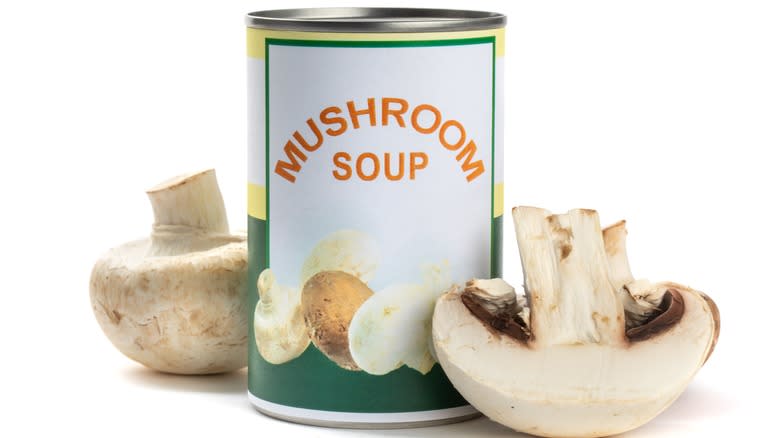
Using premade soup to boost your recipes is one of our all-time favorite cooking hacks. Canned soup can be used to augment everything from crispy fried chicken to flavorful meatloaf and is equally at home in casseroles, pot pies, and pasta sauces. Canned soup adds quick flavor to dishes and can also provide additional moisture where it's needed. As well as this, it can be used as a substitute for ingredients like cream or tomato sauce -- and as a cost-effective food item that can stay usable in your pantry for years.
Of all the soups out there to use while cooking, cream of mushroom soup might be our favorite. Cream of mushroom has a delicate yet rich flavor, which is adaptable enough to slip into a huge range of meals. But cooking with it isn't as simple as just pouring it into a recipe and hoping for the best. If used incorrectly, this dish can either turn your meal into slop or make it way too thick and gelatinous. And while it has a fairly mild flavor, picking the wrong type can leave your meal swimming with salt.
Read more: Canned Soups You Should And Shouldn't Buy
Forgetting To Use A Low-Sodium Soup
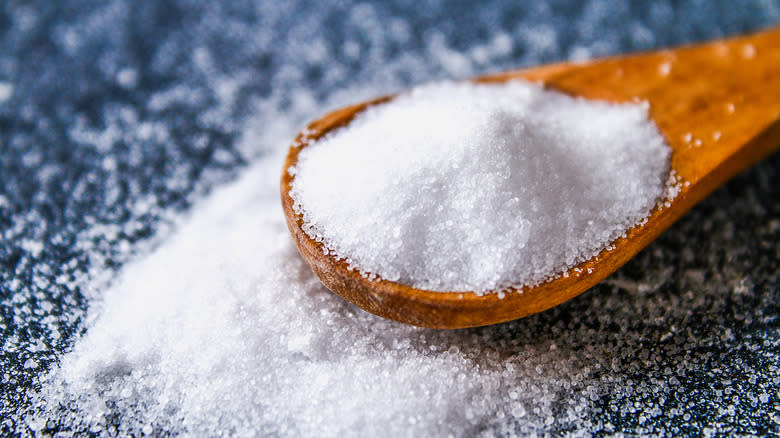
Canned soups are routinely cited as one of the highest-sodium foods out there, and cream of mushroom soup is no exception. Some of the most well-known brands use an absurdly high amount of sodium in their products, with Campbell's Cream of Mushroom Soup containing 860 milligrams in just a half-cup serving. Given that some recipes that call for cream of mushroom soup might require you to use double or triple this amount and specify that you should add salt on top of that, you could be faced with a meal that's incredibly salty.
However, an easy way to avoid this is to opt for a low-sodium or unsalted cream of mushroom soup. These soups are usually readily available and contain a fraction of the sodium of regular cream of mushroom. Campbell's' own low-sodium option, for example, contains just 30 milligrams per cup. Even its unsalted version is still full of flavor and will provide a quality mushroom taste and thickness to your meals. Additionally, using a low-sodium or unsalted option means that you can add as much or as little salt as you like.
Choosing The Cheapest Soup You Can Find
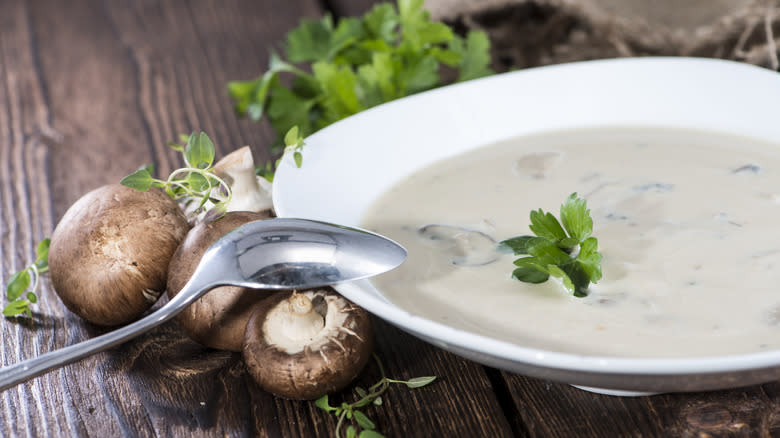
Cream of mushroom soup is a budget-friendly ingredient, part of what makes it so appealing to cook with. But it pays to spend even a few cents more on the can you're opting for. Some cream of mushroom soup products, like Walmart's Great Value Cream of Mushroom Condensed Soup, won't break the bank, but nor will they offer much flavor -- as the reviews for the product clearly show. "I'm easy to please especially in the soup department -- but it was not enjoyable," says one disgruntled customer via Walmart. The reviewer went on to point out that the product felt like it was overly processed and tasted terrible, which other customers concurred with.
The problem, though, is that if you use a product like this in your food, your whole meal is going to taste unavoidably substandard. And given that more premium products, like Campbell's, are available for as little as 50 cents more, it doesn't make sense to ruin your dinner for such a small saving. Cut-price products are also more prone to using cheap ingredients that are far from nutritious. Walmart's Great Value soup, for example, lists titanium dioxide as an ingredient, a food coloring that may have carcinogenic effects, according to the European Food Safety Authority.
Not Watering Down Your Soup
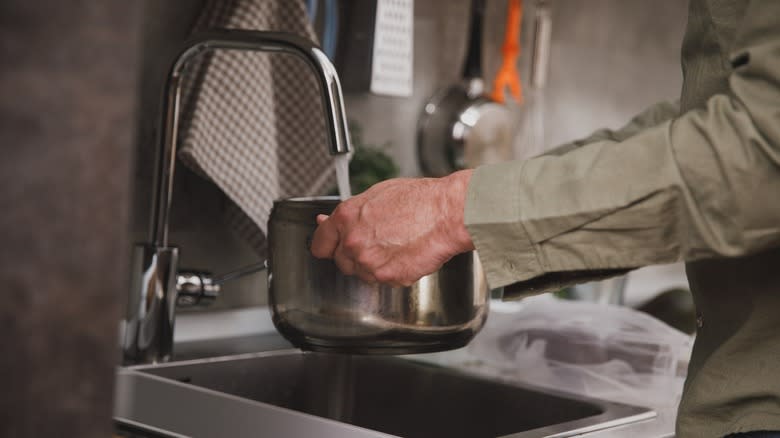
Cream of mushroom soup is superb for giving foods like casseroles and pasta bakes a thicker consistency, as well as holding all your different ingredients together. But it's easy for things to go too far. Cream of mushroom soup usually contains thickeners like cornstarch or flour, and when it's baked with carbohydrates like pasta or rice, these ingredients release further starches into the mix. The result is a meal that's dense and gelatinous.
Further issues arise when moisture evaporates from the meal as it's cooking, which can thicken the soup even more. But all of this can be avoided if you slightly water down the soup before mixing it with your ingredients. This can be especially useful if you're cooking raw ingredients like rice, which will need additional moisture to plump up and become soft. And watering down your soup can also stop it from being too salty if you've gone for a full-sodium option.
However, watering down your soup requires balance. Water it down too much, and you might end up with a sloppy mess. The best thing to do is to start with just a little bit of water. If your recipe is still too thick, adjust the ratios next time round.
Only Using It For Mushroom-Based Dishes
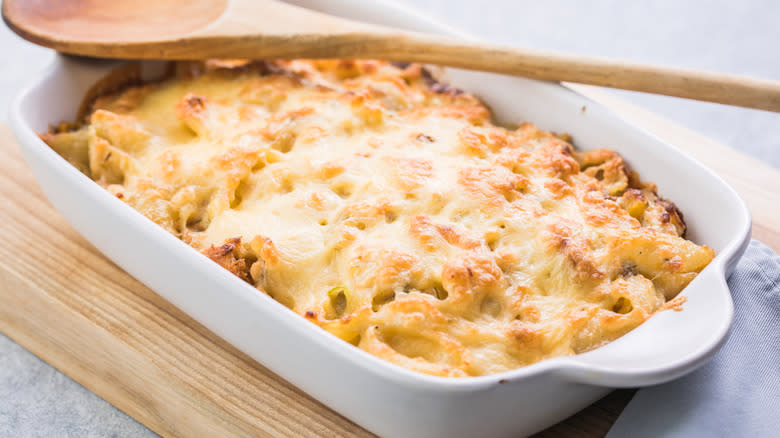
The main flavor of cream of mushroom soup is, of course, mushrooms. And so, it makes sense that it's a natural fit for recipes like mushroom stroganoff or mushroom sauce for steak. But one key mistake that people make is assuming that the flavor of the soup has to be the predominant flavor in the meal you're making -- and this is a surefire way to end up with a boring dinner.
In fact, cream of mushroom soup adds an umami-packed flavor to a wide range of recipes. If you eat meat, it can form the basis of a chicken and noodle casserole or a hearty sauce for pork chops. It's equally at home in vegetarian dishes where mushrooms aren't the primary ingredient, like broccoli and cheese or green bean casseroles. Don't forget that cream of mushroom soup doesn't just add flavor: You're also using it for its texture. And if you're worried about the mushroom flavor becoming overpowering, don't forget that you can always cut it with a little light or heavy cream to maintain the richness but give it a more neutral flavor.
Forgetting To Add Additional Flavors
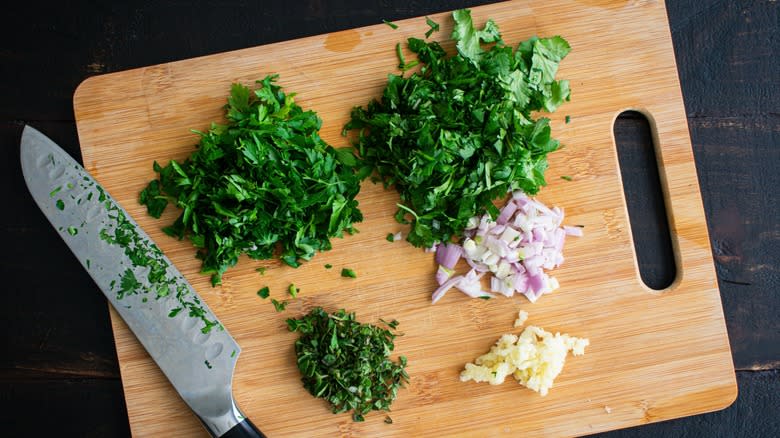
While cream of mushroom soup can be tasty, there's no denying that it's hardly the most complex ingredient out there. But it's very easy to forget that cream of mushroom soup can operate as a base to which you add additional flavors and ingredients to make your eventual meal way more delicious. If you're unsure where to start, try leaning into its natural mushroom qualities by throwing in deep-tasting porcini or shiitake mushrooms. Both of these mushroom varieties have an intense, meaty flavor and are a great addition if you're using the soup to make a sauce for chicken breasts or meat cutlets.
To develop its flavor further, try sauteeing some chopped garlic and onions before mixing them into your cream of mushroom soup. Both vegetables will give the soup a slight sweetness and boost its savory notes. If you're mixing it into a casserole, sprinkling in some dried mixed herbs will give cream of mushroom soup extra nuance. Fresh herbs are also an excellent choice if you're making a sauce from your cream of mushroom soup, although avoid putting them in anything you're baking for a significant length of time, as they'll lose their pungency.
Not Making Your Own
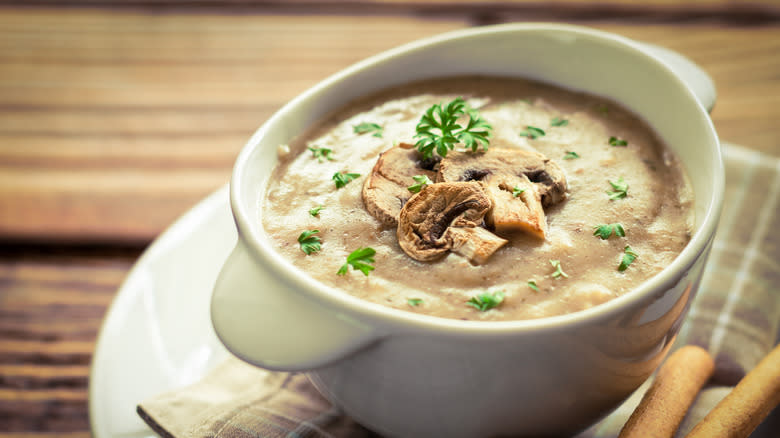
One of the main issues with cooking with cream of mushroom soup is that you're often limited to just a few options. And this can be problematic if those options are ones that you can't eat. Cream of mushroom soup is, as you might expect, made with cream, with canned products also frequently containing wheat. This takes it off the table for anybody who's following a vegan diet, has a milk allergy, celiac disease, or a gluten intolerance.
However, by making your own cream of mushroom soup, you can not only avoid adding these ingredients but can control any other additives as well. Cream of mushroom soup recipes are generally fairly simple, and the cream (or half-and-half) and butter used can be easily subbed out for a vegan cream and plant-based butter. The flour that works as a thickening agent, meanwhile, can be swapped for an alternative like cornstarch or potato starch. Making your own cream of mushroom soup also means you can control the amount of salt you put in and can add any extra flavorings in to bulk it out. Once made, cream of mushroom soup will usually last for 3 to 4 days in the fridge.
Forgetting To Add A Heatproof Thickening Agent To Watery Soup
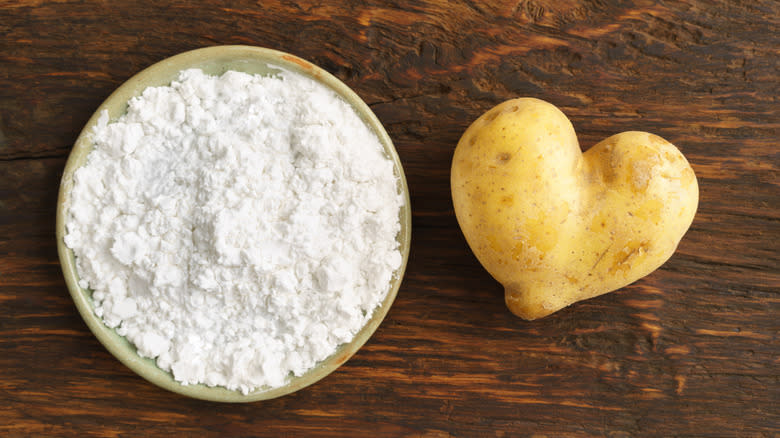
When straight out of the can or heated gently, cream of mushroom soup is thick, rich, and velvety. But when it's cooked for a significant length of time, things can start to change. Sustained high heat, such as those used in slow cookers or casserole dishes, can cause cream of mushroom soup to split. This is likely down to two factors. The first is the separation of the fats in the soup, supplied by cream, from the water content, which tends to occur when it gets too hot. The second is the breakdown of the starches used in the soup. Cream of mushroom soup tends to incorporate cornstarch and wheat flour to thicken it, and cornstarch, in particular, is prone to splitting when its starch molecules reach boiling point.
A good workaround for this, though, is to introduce a heatproof thickening agent. While potato starch may also start to break down if heated too intensely, it can tolerate high heat better than cornstarch. Try stirring some into your cream of mushroom soup before cooking with it or adding a slurry of potato starch and water just before your dish has finished cooking. Alternatively, you can shift the time you add your cream of mushroom soup to your recipe and add it towards the end to reduce its likelihood of splitting.
Using A Powdered Soup Mix
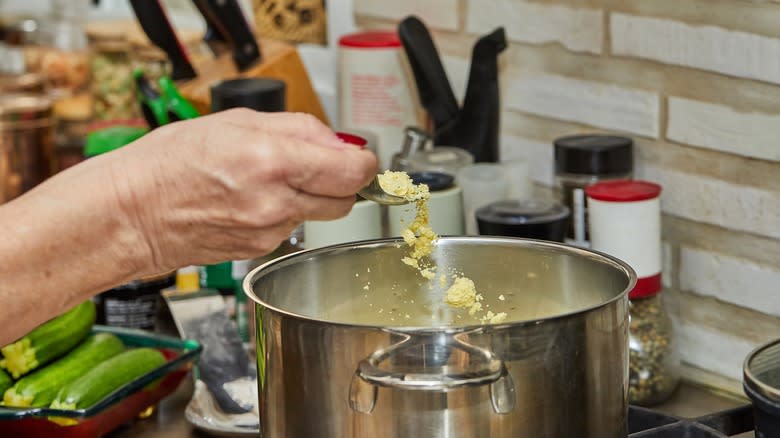
The beauty of cream of mushroom soup is that most of the time, it's ready to go straight out of the can. And not only does using powdered soup make things take longer, but you may also end up with an inferior end result. Powdered cream of mushroom soups may have certain advantages nutritionally, as they can be lower-calorie and lower-fat. However, they also tend to be lacking in flavor, meaning your meal will ultimately miss out on the boost that regular cream of mushroom soup supplies.
As well as this, the thickness of powdered soups comes from a range of thickening agents, with their "creaminess" coming from sunflower oil-based thickeners instead of the actual cream that this soup promises. And to top it all off, there's no significant advantage in terms of convenience in using these soups in recipes, as you have to prepare it beforehand instead of simply opening a tin. As canned cream of mushroom soup can last for several years in your pantry, there isn't even an argument that these soups are better storage-wise. Avoid the powdered options and pick up some cans at the store instead.
Forgetting You Can Substitute It For Other Ingredients
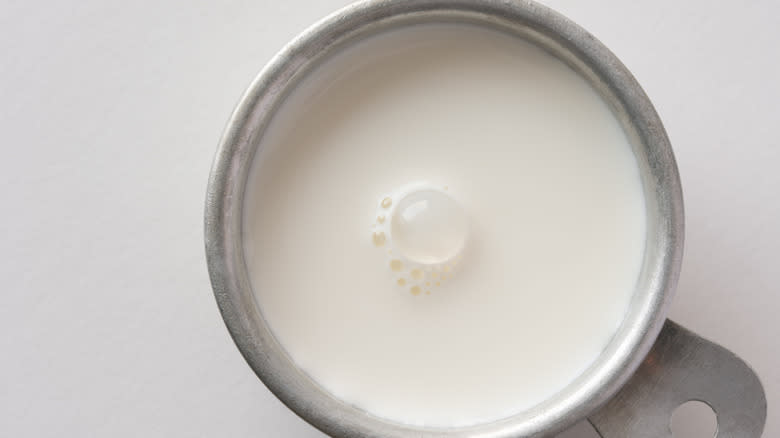
It's hard to argue with the fact that cream of mushroom soup is a versatile ingredient, but you might be surprised by just how versatile it is. All too many people forget that cream of mushroom soup can be swapped into recipes that don't call for it when in a pinch. With its creamy consistency, cream of mushroom soup is a superb substitute for both heavy cream and sour cream in savory recipes. Cream of mushroom soup has a subtle enough flavor to provide texture without being distracting, and its shelf-stable nature means that it can often be more convenient than fresh dairy products, which require refrigeration.
Cream of mushroom soup can also act as a substitute in recipes that require cream of chicken, cream of broccoli, or cream of potato soup. Additionally, it can be used to add extra flavor and richness to dishes that call for chicken or vegetable broth. Try using cream of mushroom soup to make gravy, for example, by adding a little to deglaze your skillet or casserole dish. It will save you from having to make a roux from scratch and is as simple as opening a can.
Using A Can That's Too Old
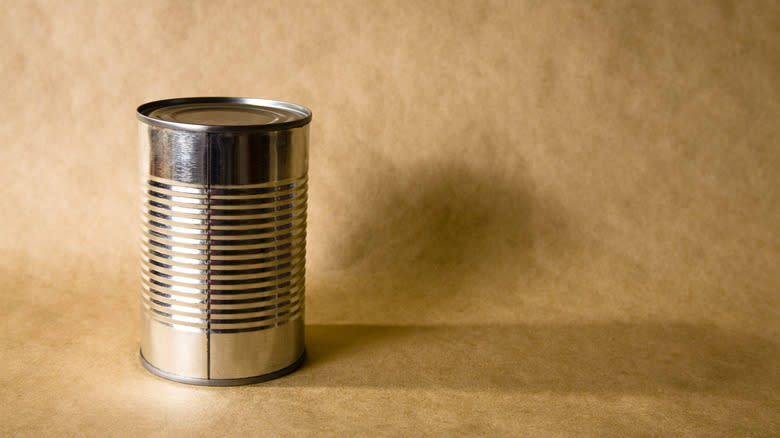
Common wisdom indicates that canned goods can last forever, and it's certainly true that if they've been stored properly, they have (in theory) a limitless shelf life. But that's still no excuse to use a super-old can of cream of mushroom soup. While they may last for longer than their use-by date, canned soups can start to lose their flavor when kept for long periods of time. Any pieces of mushroom in the soup may also be prone to deterioration, turning into mush. And the longer you keep a can of cream of mushroom soup, the longer you risk it becoming knocked or punctured or the can starting to corrode or rust. This can lead to the soup inside becoming spoiled.
Instead, stick to the use-by date and throw out cans that have gone beyond that. The good news is that you have a pretty long time to use your soup. Campbell's soup, for example, will last for approximately two years before officially being out of date. You should also check the quality of your cans periodically and ensure you throw out any that have become deeply dented or have begun to bulge.
Read the original article on Daily Meal.

